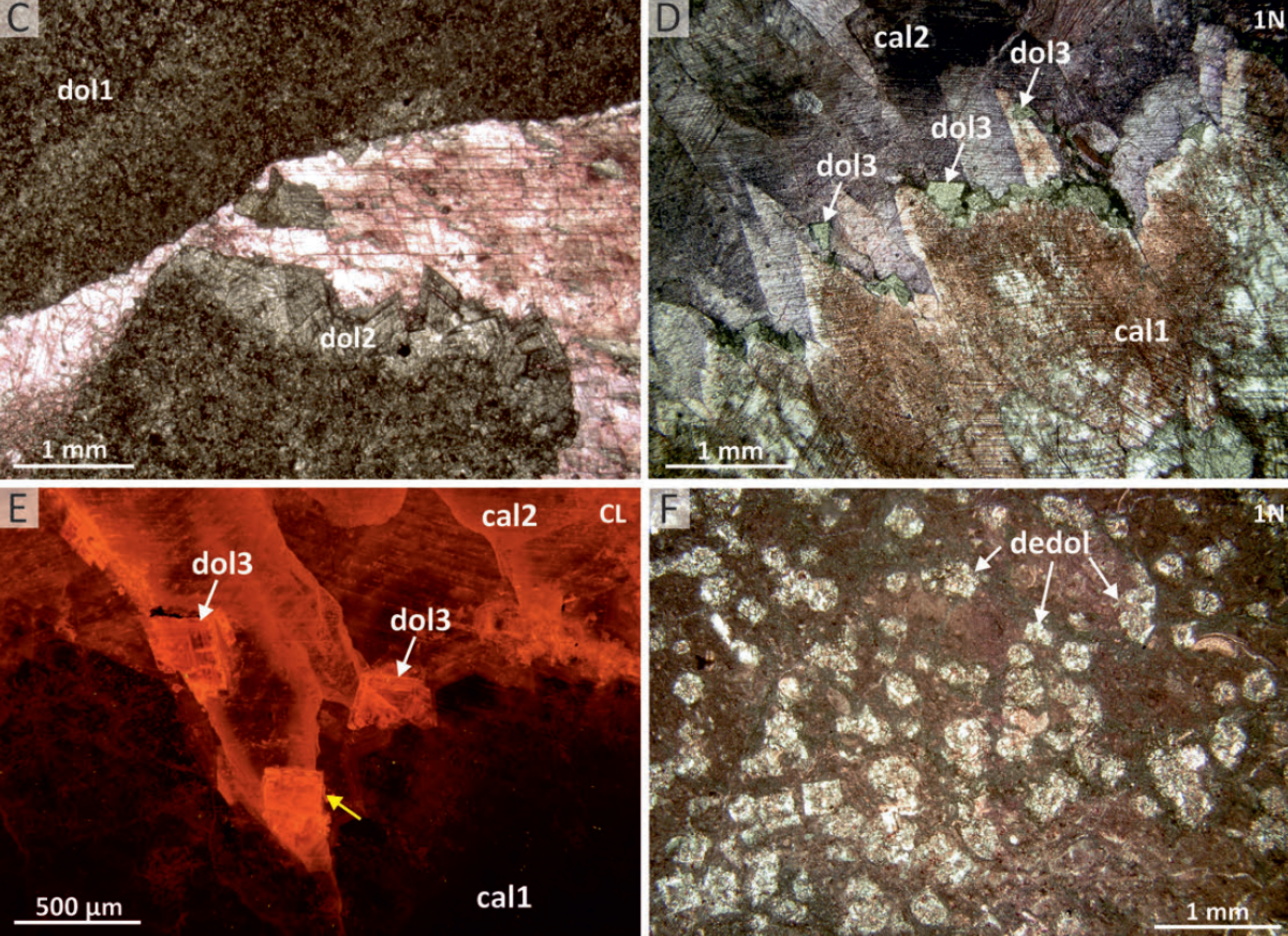Partially dolomitized Lower Jurassic limestone in the Kálvária Hill, Tata
Abstract
A few meter sized dolomite body was found in the Lower Jurassic limestone strata of the Kálvária Hill, Gerecse Mts. The dolomite is unique, both in the outcrop and in the Jurassic beds of the Gerecse Mts. It is laminated, yellow-red and follows a fracture, further invading the host Jurassic limestone along a bedding plane. Dolomite, replacing the host rock is fine to medium crystalline, and locally saddle dolomite crystals were observed. A breccia zone cuts across the dolomite body, however brecciation was not observed within the dolomite, only calcite veins are present. The breccia zone is cemented by white-grey-yellow calcite that incorporates dolomite crystal fragments. Calcitized dolomite crystals were found in the host Jurassic limestone next to the breccia zone. The three different dolomite types are most probably associated with the same dolomitization event. Dolomitizing fluids could have migrated through fractures and occasionally along bedding planes. Dolomite crystal fragments – found within zones of the breccia cementing calcites – could have been derived from the dolomitized host rock. The stable isotope data of the dolomite suggest that dolomitization took place most probably in the burial realm, either from the existing pore water or hydrothermal fluids, migrating through fractures in the lithified Lower Jurassic limestone. Post-sedimentary character of the fractures suggests post Late Jurassic age for the dolomitization. Meteoric origin of the calcite found in fractures and as cement in the breccia zone, points to subaerial exposure. This would mean pre-Late Cretaceous–Paleogene dolomitization event.
References
DAVIES, G.R. & SMITH JR., L.B. (2006) Structurally controlled hydrothermal dolomite reservoir facies: An overview. — AAPG Bulletin 90, 1641‒1690. https://doi.org/10.1306/04300706142
DICKSON, J.A.D. 1966: Carbonate identification and genesis as revealed by staining. — Journal of Sedimentary Research 36, 491–505. https://doi.org/10.1306/74d714f6-2b21-11d7-8648000102c1865d
FODOR L 2010: Mezozoos-kainozoos feszültségmezők és törésrendszerek a Pannon-medence ÉNy-i részén – módszertan és szerkezeti elemzés. — Akadémiai doktori értekezés Budapest, 135 p.
FODOR L. & FŐZY I. 2013. Late Middle Jurassic to earlist Cretaceous evolution of basi geometry of the Gerecse Mountains. In: FŐZY I. (ed): Late Jurassic–Early Cretaceous fauna, biostratigraphy, faces, and deformation history of the carbonate formations in the Gerecse and Pilis Mountains (Transdanubian Range, Hungary). Institute of Geosciences, University of Szeged, GeoLitera Publishing House
FÜLÖP J. 1975 Tatai Mezozóos alaphegységrögök. — Geologica Hungarica ser. Geologica, 16, 229 p.
GYŐRI O. 2014: Paleofluidum áramlási események nyomozása Dunántúli-középhegységi mezozoos karbonátokban, — Doktori értekezés ELTE, 148 p.
HAAS J. 1995: Az Északi Gerecse felső-triász karbonátplatform képződményei. — Földtani Közlöny 125, 259–293.
HAAS J. & HÁMOR G. 2001: Geological garden in the neighbourhood of Budapest, Hungary. – Episodes 24 257–261
HAAS J., J. EDELÉNYI E., GIDAI L., KAISER M., KRETZOI M., ORAVECZ J. 1984: Sümeg és környékének földtani felépítése. — Geologica Hungarica ser. Geologica 20/LVII. pp. 1–353
HAAS J., BUDAI T., GYŐRI O. & KELE S. 2014a: Multiphase partial and selective dolomitization of Carnian reef limestone (Transdanubian Range, Hungary). — Sedimentology 61, 836–859 https://doi.org/10.1111/sed.12088
HAAS J., BUDAI T., GYŐRI O. & KELE S. 2014b: Similarities and differences in the dolomitization history of two coeval Middle Triassic carbonate platforms, Balaton Highland, Hungary. — Facies 60/2, 581–602 https://doi.org/10.1007/s10347-014-0397-1
HAAS J., BUDAI T. & DEMÉNY A. 2014c: Partial dolomitization of foreslope and toe-of-slope facies of a Carnian carbonate platform, Transdanubian Range, Hungary. — Central European Geology 57/1, 1–19 https://doi.org/10.1556/ceugeol.57.2014.1.1
HAAS J., LUKOCZKI G., BUDAI T. & DEMÉNY A. 2015: Genesis of Late Triassic peritidal dolomites in the Transdanubian Range, Hungary. — Facies 61/3, Paper 8 https://doi.org/10.1007/s10347-015-0435-7
HAAS J., HIPS K., BUDAI T., GYŐRI O., LUKOCZKI G., KELE S., DEMÉNY A. & POROS ZS. 2017: Processes and controlling factors of polygenetic dolomite formation in the Transdanubian Range, Hungary: a synopsis. — International Journal of Earth Sciences 106/3, 991–1021 https://doi.org/10.1007/s00531-016-1347-7
HIPS K., HAAS J., POROS ZS., KELE S. & BUDAI T. 2015: Dolomitization of Triassic microbial mat deposits (Hungary): origin of microcrystalline dolomite. — Sedimentary Geology 318, 113–129 https://doi.org/10.1016/j.sedgeo.2014.12.002
HIPS K, HAAS J. & GYŐRI O. 2016: Hydrothermal dolomitization of basinal deposits controlled by a synsedimentary fault system in Triassic extensional setting, Hungary. — International Journal of Earth Sciences 105:1215–1231 https://doi.org/10.1007/s00531-015-1237-4
KÁZMÉR M. & KOVÁCS S. 1985: Permian-Paleogene paleogeography along the eastern part of the Insubric-Periadriatic lineament system: Evidence for continental escape of the Bakony-Drauzug unit. — Acta Geologica Hungarica 28, 71–84
MACHEL, H. & LONNEE, J. 2002: Hydrothermal dolomite‒‒a product of poor definition and imagination. — Sedimentary Geology 152:163‒171 https://doi.org/10.1016/s0037-0738(02)00259-2
QING, H. & MOUNTJOY, E.W. 1992: Large-scale fluid flow in the Middle Devonian Presqu’ile barrier, Western Canada Sedimentary Basin. — Geology 20, 903–906 https://doi.org/10.1130/0091-7613(1992)020<0903:lsffit>2.3.co;2
QING, H. & MOUNTJOY, E.W. 1994: Formation of coarsely crystalline, hydrothermal dolomite reservoirs in the Presqu’ile barrier, Western Canada Sedimentary Basin. — AAPG Bulletin 78, 55‒77 https://doi.org/10.1306/bdff9014-1718-11d7-8645000102c1865d
ROSENBAUM, J. & SHEPPARD, S.M.F. 1986: An isotopic study of siderites, dolomites and ankerites at high temperatures. — Geochimica et Cosmochemica Acta 50, 1147–1150. https://doi.org/10.1016/0016-7037(86)90396-0
SPÖTL, C. & PITMAN, J.K. 1998: Saddle (baroque dolomite) in carbonates and sandstones: a reappraisal of a burial diagenetic concept. — IAS Special Publication 26, 437–460 https://doi.org/10.1002/9781444304893.ch19
SPÖTL, C. & VENNEMANN, T.W. 2003: Continuous-flow isotope ratio mass spectrometric analysis of carbonate minerals. — Rapid Communications in Mass Spectrometry 17, 1004–1006. https://doi.org/10.1002/rcm.1010
SZIVES O. 2007: Aptian-Campanian ammonites of Hungary — Geologica Hungarica ser. Palaeontologica 57, 182 p.
















